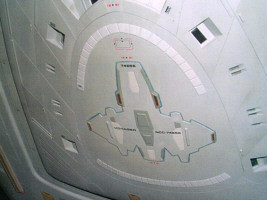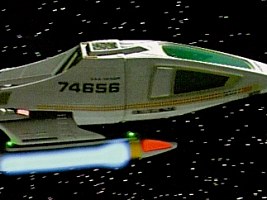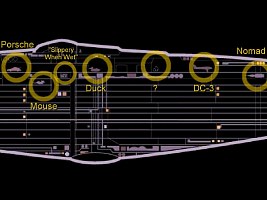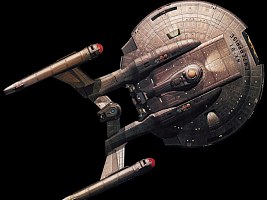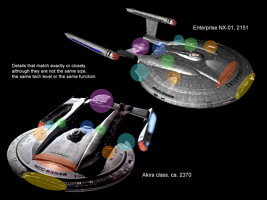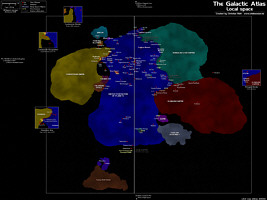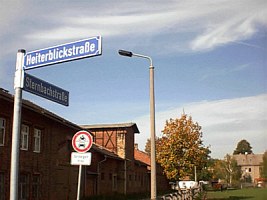Interview with Rick Sternbach
Rick Sternbach has been working with the Star Trek Art Department since "Star Trek: The Motion Picture". He developed the 24th-century style of the props for Star Trek: The Next Generation, most notably of phasers and tricorders, and designed the Klingon Vor'cha cruiser and the Cardassian Galor class. As theSenior Illustrator and Technical Advisor of Star Trek Voyager he created, among many other items, the starship Voyager and the Delta Flyer.
I was lucky to ask Rick quite a few questions on behalf of our Trek tech fan group, the ASDB.
Ex Astris Scientia: Aside from your well-known favorite designs like the USS Voyager, which of your creations for Star Trek would you have liked to work out in more detail?
Rick Sternbach: The AeroShuttle, of course, which could have been adapted from the Runabout interior sets to save money. Foundation Imaging did a very cool demo of the AeroShuttle deployment, but nothing ever came of it. I wish we had been able to do a few more details on some of the hand props like the phasers, PADDs, et cetera, and more large-scale bits of the Type 12 Shuttle and the Delta Flyer. Most of these wish-list things would have been expensive, but not impossible.
EAS: Is it correct to assume that the aeroshuttle docking sequence was simply too expensive, without a good story requiring its appearance? Not that I would want to miss the Delta Flyer, but wouldn't it have been the logical choice to show us the (upgraded?) aeroshuttle instead of building the Flyer from scratch in "Extreme Risk"?
RS: I don't believe the CGI portions would have been that much more expensive to produce than those for a typical episode or two-parter. Foundation Imaging had completed the basic body of the Aeroshuttle and animated it for a test on their own time. What would have cost the company more would have been the cockpit or other interior sets, though I'm sure that the Runabout sets, had they been preserved, would have been fairly cheap to rework. I have no problem with seeing the Delta Flyer either, since it gave me a chance to come up with a very cool shape.
EAS: Considering that the aeroshuttle was never seen and not even mentioned in the whole series, does it exist at all on the real ship? If yes, do you have an explanation why it remained docked and forgotten for all the seven years?
RS: It certainly exists because the planform was seen in the belly of the forward section of Voyager. Whether the vehicle was spaceworthy is a whole other question. Perhaps the story reason why it never flew was that Voyager had to leave before all systems were installed. Logically that wouldn't have stopped them from finishing it off en route, since they managed to build a lot of shuttles and two Delta Flyers during the same period. The production reasons likely involved lack of story opportunities, not understanding the Aeroshuttle was there, and even not wanting to copy the Captain's Yacht gag from ST: Insurrection.
EAS: After it had been called "Type 9" (and later "Class 2") on screen, I was surprised to read "Type-12 shuttle" in the September 2001 issue of Star Trek: The Magazine. I assume you prefer "Type 12" because "Type 9a" is the cargo shuttle from the TNG Technical Manual?
RS: I don't know where Type 9 came from, since my sketches and blueprints nailed it as a Type 12. As for "Class 2," that was a writer thing; they were always mixing up class and type for everything from ships to planets. Obviously no one boned up on real aircraft and naval vessel nomenclature.
EAS: Speaking of prop details, do you sometimes see that a little detailed device got too close to the camera, and you only hope that the viewers didn't notice?
RS: I can't say with certainty that it ever happened with props, but it has happened a lot with graphics. I didn't get too involved with the more recent shows, but I recall on TNG that the gag objects on the Main Engineering display were seen a little too clearly. The DC-3, the hamster wheel, NOMAD, those little guys.
EAS: Is there anything you created that you are not content with at all, something you would like to forget? ;-)
RS: Maybe not so much my contributions, because I really did *try* to satisfy all the different design requirements and the producers' whims, but I think some of the Kazon bits didn't work for me, especially the nondescript hand props (though the pistols were fun). They weren't particularly interesting villains; nobody I know liked their hair.
EAS: My theory why they were attacking Voyager all the time is that they wanted to know the secret of Janeway's hairdo. But because of the Prime Directive she refused to give them the technology. :-)
Irrespective of what you have created for the show, do you have a favorite and a least favorite episode?
RS: I'd have to think about those for a bit, and I don't have any episodes on tape to go back and review, but I think I'd have to say that I liked "Year of Hell" for all the great tech we did with a good story (regardless that some techy folks might think I'm biased toward hardware, I've actually always valued good writing partnered with good tech as being the unbeatable combination for media SF). Never mind the fact that Voyager was obliterated but all was set back to "normal" at the end of the two-parter. I might have to nominate the giant flying virus bug episode as a low point for me, even if Janeway did do the Ripley bit with a big gun.
EAS: What is the condition of the Voyager Technical Manual? The latest we have on it is that Pocket Books turned you down. Would you be able/allowed to do it on your own? Is there a chance we could see something like an online TM by you (hint: for which you would most likely have many helpers in the online fandom community)?
RS: Since Pocket Books/Simon & Schuster has the license for Star Trek books, they're the only ones who could publish a potential Voyager TM. I'm not inclined at the time to work with them, due in part to the editorial differences of opinion I had with them over the 1701-D blueprints and DS9 TM. With ENTERPRISE now on the front burner and Pocket Book's publishing directions changed to mostly fiction and a few specialty items like the calendars, I rather doubt the Voyager TM will ever see daylight. I would not be at all interested in taking on a private press effort because of the license infringement issue and the costs involved; likewise I will not be able to lend my name or expertise to any fan-originated TM, web-based or not.
EAS: That's really a pity. Maybe, irrespective of Enterprise, it has also to do with the fans' apparently fading interest in Voyager during the past few years, unlike it was the case with TNG or DS9?
RS: Not having my finger on the pulse of the fan viewing community, I couldn't honestly say what the level of interest in Voyager became, or what steered Pocket Books away from the tech books. It may have been a combination of waning interest and the harsh economic realities of doing big flashy publications.
EAS: And while I'm at it, Rick Berman and Brannon Braga recently quite openly admitted that their ideas with Voyager were exhausted. In retrospect, do you have the impression that the final Voyager season was more or less boring routine work, while everyone was rather excited about developing a new show?
RS: Depends on which department you ask. In the art department, we were continuing to develop cool sets, ships, and props right through to the end, and we were jazzed about it. If the writers and producers were losing steam, that's unfortunate. I don't accept the notion that there weren't more good stories to tell, if anyone was saying that the Voyager scenario was tapped dry. Good SF can be drawn from anywhere.
EAS: I liked the design of the seventh season very much. One reason is the deliberate use of CGI to show the vastness of space as well as of planet sets (most notably in "Workforce"). Aside from that I seem to notice a tendency to move the alien starships and sets away from organic shapes to a more utilitarian and perhaps more realistic look.
Is there anything left you are or will be doing in the field of Star Trek?
RS: At the present time I'm working on Star Trek X, the latest feature film. We're in pre-production, and my specific work involves mainly graphics in the film's art department.
EAS: Glad that you are back at the drawing board. Good luck! According to the synopsis published earlier this year, the Romulans are supposed to play a major role in the film. Can we hope that the budget will allow new Romulan gadgets and starships, other than in TNG and DS9 where there was little variety?
RS: I don't know exactly what we're going to see in that area, because we're only just starting. The different departments are working hard on various designs; I've come in contact mostly with graphics, and I can't tell you what we're developing! :)
Update notice There is a more recent interview about Rick's work on "Nemesis" at Trekweb.
EAS: We will be patient.
What other projects are you currently pursuing? What future plans do you have?
RS: We'll be doing the feature film first-unit work until roughly mid-March, after which I'll be hunting down any new science fiction feature illustrator jobs that come along; in the off hours, I'm working on astronomical art and space education products related to Mars and interplanetary flight.
EAS: In a way, your profession (sci-fi art) is what other individuals have as their hobby, while what you do in your off time appears quite "serious". At least in my case (I'm an engineer in the real world) it is just the other way round. :-) Do you sometimes wish you would work as an engineer and actually build what you have in mind?
RS: I thought for sure I'd wind up doing aerospace engineering as I got ready for college in 1969; mediocre grades and the disintegration of the Apollo program made sure I'd lean into the art world. I've worked with scientists and engineers on real-world projects; I still don't know if I can characterize myself as being in one camp or another, since I like doing both SF and real space. Sure, I've spent the last 14 years in the SF/fantasy/media world, but I've always maintained contacts with folks from JPL, KSC, Ames, and so on.
EAS: Compared to the 1960s, real space travel seems to have lost its attractiveness to the common public. What would you like to do to recapture the old spirit (aside from actually launching a manned mission to Mars which would definitely boost the interest)?
RS: I would ask NASA to kick their PR/PAO efforts into higher gear to get people interested, even in a world of increasingly numerous diversions like going to the movies, burning CDs, and chatting on the Internet. Seriously, the agency has not had the greatest record in capturing the world's attention, though I must say that there are a lot of dedicated space educators working with the kids and parents to get that spirit of adventure going again. I try to get my kids excited and at least thinking about space, even if they don't go for it the way I do. If you're excited and show them something cool and interesting, they'll consider it before going back to whatever it was they were doing.
EAS: The most obvious question: "Enterprise?" What do you think about the premise? The continuity?
RS: I think the premise has great potential, though as I stated earlier in the year I would have set the story at least fifty years earlier, to give the audience a real taste of the difficulties of interstellar flight and meeting up with aliens from nearby systems. As it is, the technology (and the technobabble) has been brought rather quickly up to what we were seeing in TNG and maybe even Voyager's time. That's for the producers to live with; I think they could have been a bit more clever with the terminology and capabilities (or lack thereof) of the hardware. The speeds and distances make no sense anymore, which is unfortunate given the people on staff and from outside who could very easily put Archer's universe into some order that would not strain scientific plausibility *too* terribly much. A certain amount of rule-bending is acceptable for drama's sake, but with Qo'noS only 1.5 lightyears from Earth (do the math), I feel a bit let down. The stories so far sound too familiar. Is Star Trek less than literate SF? Perhaps it always was, though I had hoped for some time that it would at least *attempt* to be the media equivalent of the writings of Ted Sturgeon, Anne McCaffery, Poul Anderson, Fred Pohl, Robert Heinlein, Ursula LeGuin, Larry Niven, or Joe Haldeman; many I've known as friends and whom I've read and illustrated for years.
EAS: It seems that Braga and Berman wanted to retain as much as possible of what is immediately recognizable as Star Trek. Unfortunately this seems to include plot recycling and little changes in the fictional technology. Do you have an advice to the Enterprise authors? Maybe you even have a script idea?
RS: Not my area of responsibility; sure, I've got a lot of ideas, some that might even make good Enterprise episodes, but ultimately the writers and producers will have to decide how hard they want to work to keep stories like "Terra Nova" from copying Voyager's "Friendship One." They must have their reasons for doing what they're doing; for the moment those reason elude me, because I know that there are many, many sources of inspiration from the literate SF universe that would make terrific Enterprise stories.
EAS: What about the starship NX-01? What would you have done differently?
RS: I would definitely have made the Enterprise different than what we see on screen; various circumstances led the production team to choose to Akira class as a starting shape, even though we know of its existence as a "future" vessel. The rationale for the shape similarities might be easily explained in a fictional sense, though I doubt the issue will ever come up in a story. If and when I get a couple of quiet weekends, I might sketch up my own direction for the ship.
EAS: We would love to see your ideas on the ship! Could it have been a "political" decision to modify the basic shape of the Akira, in order to adhere to the established style that Star Trek is commonly identified with?
RS: One story I've heard is that the producers thought the original sketches for the NX-01 looked a bit too close to the TOS Enterprise, so one of them pulled out a picture of the Akira and offered it as a ship that hadn't been seen very much, making it a possible contender. They were informed that the Akira was indeed a known vessel, so they instructed the designers to stick with the basic shape but change it to an older-looking ship.
EAS: Theories include Cochrane finding an Akira schematic on a PADD left behind by Picard's crew, or the design of the Akira class being a homage to the good old NX-01. But as an engineer I wouldn't try to imitate a mere shape using a less advanced technology or a more advanced one, respectively. Neither explanation would make a good story anyway.
From several "making of" articles we know that usually the major starships like the USS Voyager are created from scratch and undergo several complete revisions until they are finally approved of. I wonder what "The Making of NX-01" could look like, other than showing a straight way from the Akira to the NX-01 which retains even characteristic details of the Akira. Of all things developed for the series, wouldn't the major starship have deserved more of a creative process?
RS: Hard to say. I wasn't in the loop on this one, but from the people I've talked to who had a hand in the NX-01 birth, the approvals process was a real bear. I'm somewhat glad I wasn't involved, having had a relatively easy time with Voyager, DS9, and TNG, though a small number of vessels and props went through a lot of changes. I haven't seen more than one or two early NX-01 sketches, so I don't know exactly how much ink was laid down trying to get the ship designed. I might eventually sketch up a few precursors to the TOS Enterprise, but don't hold your breath. I'm sure a lot of your colleagues in ASDB and other groups could *easily* fill in the gaps between the Ares IV and the NCC-1701.
EAS: Well, at least the ship in the opening credits and the Conestoga from "Terra Nova" fit in quite well, so it will be definitely fun to design ships of this era.
What do you think of the ASDB's work so far? Maybe you have any contributions?
RS: The site looks like a lot of fun. It's always good to have an outlet for creative starship juices, so keep it up. If I had one bit of advice to give, it would be to steer away from cut-n-paste designs using bits from existing designs, but really taking the time to puzzle out the evolutionary steps from one ship to another, or extrapolating the next class of ship required based on improvements in technology. We did it a little too late on Voyager, but I did make the attempt to evolve the phasers, evolve the shields, etc. Why not work up a ship hull with a new shield emitter to replace the usual grid? Make the phaser strips narrower and make them more reddish-brown. Change the RCS thruster quads to conformal plates that are a dark copper, not burnt orange. Change the hull color to a pearlescent copper. That sort of thing. Evolve the technology, don't just use the same elements over and over. I think you'll find the discussion level about cool stuff kicks up higher!
EAS: The main reason why the style of the hull plating and details is so familiar is that most of our ships are set in the time between the Ambassador and the Galaxy, and we're trying to interpolate, rather than extrapolate. But you're right that we should do something about the newer ships. If you have any unseen sketches for Trek ships, you're more than welcome to send them to us!
RS: Basically, I look at contemporary developments in space technology, materials science, energy production, that sort of thing, and imagine a bunch of engineers conferencing over subspace about how to improve this or that system, and go from generalities down to specifics. "Jack, if we replace the transport emitter cap plate with bertnernium, we can cut the element size to sixty centimeters, and the number of discrete element connections down to five." "Right, Bob, and the only effect that'll have on environmental coatings will be a change from the Monomol 683a [a peach color] to 842 [a metallic brown], assuming the lab tests give us the fifty year lifetime." "Good. We'll wait for the samples and the sims to tell us. I also think we can eliminate the redundant pair coverage on both the +Y and -Y surfaces of the vehicle, even on the shuttles. The new EPS connections are reliable enough to allow us to install one emitter top and one bottom, and if one goes out, we just transport through the structure on the opposite vector."
See how easy it is? :)
EAS: Although I never considered that in such detail, I agree that simplifying things, saving material and weight, and saving cost in general is indeed what engineers take care of, aside from making it work. This will probably be still the same 400 years from now. Or, as Leonard McCoy would say: "I know engineers. They love to change things."
By the way, do you think that the color of the hull plates of a real starship is actually paint (as Archer in "Broken Bow" suggests), although it often looks very metallic?
RS: He says something about scraping the paint off the hull, right? I'm sure that's just an expression; the outer coating might really be some exotic anti-erosion coating sprayed on and baked or electrobonded in some way, but not paint in the traditional sense.
EAS: Let us conclude with a few common cartography questions. Is there any particular reason why the Beta Quadrant is almost never mentioned, neither in DS9 nor in Voyager? Why has Voyager never reached the Beta Quadrant?
RS: I can only guess that the writers simply wanted to keep only the Delta Quadrant in people's minds, without having to deal with anything new. They didn't deal with what I call "situational tech" like Voyager's location/trajectory terribly well, even with adequate explanations and diagrams.
EAS: Why don't Trek authors listen more often to the suggestions of technical advisors which would usually require to change only one word or figure in the script? In the field of astronomy, for instance, they could have mentioned real stars more often, or they could easily have used consistent speeds and distances instead of the "plot drive".
RS: I got two basic (and admittedly simplistic) impressions about this over time: first, they controlled the stories and ideas, to the exclusion of outside influences; second, they didn't totally trust the information some of us were giving them. The distances and speeds got a bit silly, of course, to the point where Worf could zip home from Bajor to Qo'noS during a commercial break. Tech continuity issues always gave the writers headaches, but that's their problem. I'll always believe that the constraints established by the situation can lead to *better* drama, but few people seem to have latched onto this fact. After fourteen years, I've pretty well solidified my feeling that Star Trek, while good space fantasy, isn't exactly literate science fiction, and the producers are probably quite comfortable with that. However, I must say that Jeri Taylor did adopt a lot of sci/tech verbiage offered to her, and did try to introduce interesting hardware usage ideas now and then, and I thank her for that. She didn't jump on a cool tech concept for every episode, but when it worked with the drama, she pushed for it. I'm all for the tech, but I respect the need to integrate it into the story. The science and technology in TNG was far better than in Voyager, but then they're not the same show. This isn't to say that the tech in Voyager couldn't have been better handled, it's just a matter of the personalities involved in the writing and producing, and where they wanted to take the series. I can't get into their heads; I can only comment on what I saw happening.
EAS: A popular question of fans is about the distance between Earth and Bajor. What do you think is this distance, or how large is the region of the "Federation Core Worlds", as mentioned in the DS9TM?
RS: I believe we tried to nail the Earth-Bajor distance at about 52 l.y.; I haven't looked at the text lately. I don't think you can nail a total diameter or volume of the Federation, since the protected space or controlled space or allied space takes on the shape of a big amoeba with pseudopods extending outward. However, the central original worlds of the Federation might describe a sphere roughly 20 l.y. in radius.
EAS: Thanks a lot for taking the time to answer our questions. Christian is very grateful for your help too, and thanks to his initiative a street in his home town was named for you. ;-)
RS: No fooling? Wow, how cool is that! Thanks for the photo. I'll make a big print-out and pin it up in the office. People will be jealous. :)
EAS: Yes! The Sternbachstraße is authentic.
Credits
Thanks a lot to Rick Sternbach, of course. His homepage with more information on his projects can be found at www.ricksternbach.com. Thanks also to my buddies at the ASDB, in particular J and Christian, for several of the questions. The full interview can be found at Christian's site, Star Trek Dimension, too.

Back to Reports & Interviews index






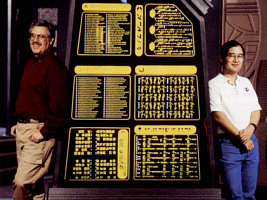
 Rick Sternbach (left) and Michael Okuda (30 Jahre Star Trek)
Rick Sternbach (left) and Michael Okuda (30 Jahre Star Trek)